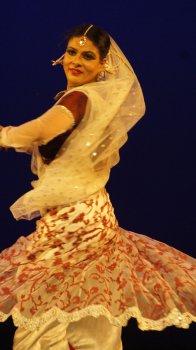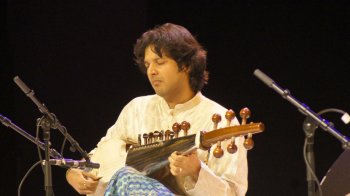
|   |

|   |
Natya Tarangini’s Bhavayami - Shveta Arora e-mail: shwetananoop@gmail.com Photos: Anoop Arora October 6, 2014 Natya Tarangini was back with a new edition of the Parampara series titled ‘Bhavayami’ - an aesthetic representation of dance, music and literature, at the Kamani auditorium on the 3rd, 4th and 5th of September. On the 2nd day, Abhimanyu and Vidha Lal (Kathak) and Ayaan Ali Khan (sarod) performed.  Abhimanyu & Vidha Lal Vidha and Abhimanyu are the daughter-in-law and son of guru Geetanjali Lal and have many performances and awards to their credit. Ayaan Ali Khan is the son and disciple of Amjad Ali Khan. The evening began with Abhimanyu and Vidha doing a duet ‘Hari-Hara.’ Hari or Krishna and Hara or Shiva worship each other. But their similarities and dissimilarities are brought out by juxtaposing their attributes. One is vanshidhara (plays a flute) and the other pinakdhara (holds Shiva Dhanush). Vidha and Abhimanyu went on to do some mesmerizing nritya while elucidating the attributes of the two gods, and ended with a stance with Vidha holding a flute and Abhimanyu holding the agni (fire) and damru (small drum). Next, they presented some nritta pieces, various chalan and bandish from the Jaipur gharana, finishing with a ‘Lamchandparan.’ Both excelled in their own spaces, Vidha with her pace and chakkars and Abhimanyu with the exactitude of his footwork.  Vidha Lal The following piece was a composition by the bhakta poet Raskhan in raag Meghmalhar in teen taal. Music and choreography was by Geetanjali Lal. With a tree projected in the background on the screen, Vidha danced to the bhajan “morpankha sir upardhaarihon” (He who wears a peacock feather on his head). The composition articulates the emotions of Radha, who is jealous of the flute on Krishna’s lips. While enacting the piece, Vidha portrayed the gopis going around their chores - cooking, drawing water from the well or fetching water from the Yamuna. They get distracted by the sound of the flute and go out to look for Krishna. Radha takes away his flute, imitating Krishna wearing the mormukut, and wearing the garland around her neck, but not playing on the flute. Vidha did a tukda showing Krishna stealing butter, and an attractive peacock dance in this piece. Her shoulder, neck and eye movements were compelling. Finally, they presented some more technical pieces, which Abhimanyu described aptly as running by him and spinning by Vidha. Abhimanyu exhibited immense energy, pace and rhythm with his footwork, and Vidha with her spins. They executed clockwise and anti-clockwise spins, and then it all culminated in a jugalbandi of clapping and tapping by the audience. Accompanying them were Aman Ali on tabla, Amjad Ali on vocals, Rishi Shankar Upadhaya on pakhawaj, Salim Kumar on sitar and Ahsan Ali on sarangi. Vidha said, “The abhinaya piece is one of my favourites since it was created by my guru Geetanjali Lal. Usually we have a piece in which Radha and Krishna are shown as a romantic couple or where Radha is annoyed with Krishna. But this piece has different emotions. She sees the flute as another maiden and is jealous of it. She is prepared to do anything for Krishna except let the flute touch his lips. It is a piece close to my heart since it is associated with the love of Radha and Krishna. Besides, it is the rainy season and the composition is based on raag Meghmalhar. The Delhi audience is exposed to many performances so it is difficult to please them. We chose the best of the repertoire of the Jaipur gharana. It should be crisp and appeal to the audience and should have a crescendo. Instead of doing a jugalbandi with the tabla player, we did it with the audience to connect with them.”  Ayaan Ali Khan
Ayaan Ali Khan played raag Bageshwari on sarod. The melody of the composition, its ascent and descent, enchanted everyone in the audience. Accompanying him were Mithilesh Kumar Jha and Anubrata Chatterjee, both on tabla. Shveta Arora is a blogger based in Delhi. She writes about cultural events in the capital. |